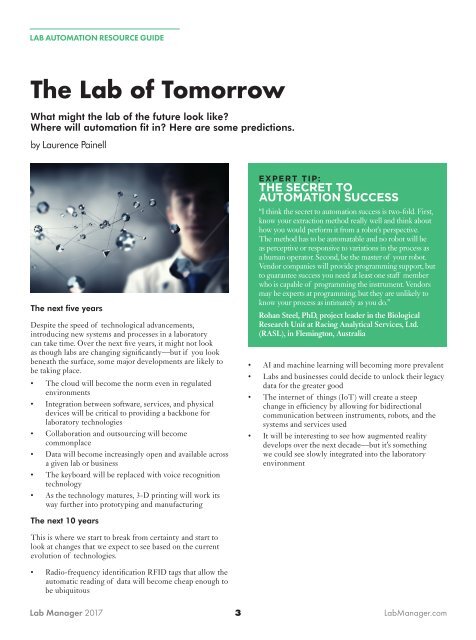Lab Automation
Create successful ePaper yourself
Turn your PDF publications into a flip-book with our unique Google optimized e-Paper software.
LAB AUTOMATION RESOURCE GUIDE<br />
The <strong>Lab</strong> of Tomorrow<br />
What might the lab of the future look like?<br />
Where will automation fit in? Here are some predictions.<br />
by Laurence Painell<br />
The next five years<br />
Despite the speed of technological advancements,<br />
introducing new systems and processes in a laboratory<br />
can take time. Over the next five years, it might not look<br />
as though labs are changing significantly—but if you look<br />
beneath the surface, some major developments are likely to<br />
be taking place.<br />
• The cloud will become the norm even in regulated<br />
environments<br />
• Integration between software, services, and physical<br />
devices will be critical to providing a backbone for<br />
laboratory technologies<br />
• Collaboration and outsourcing will become<br />
commonplace<br />
• Data will become increasingly open and available across<br />
a given lab or business<br />
• The keyboard will be replaced with voice recognition<br />
technology<br />
• As the technology matures, 3-D printing will work its<br />
way further into prototyping and manufacturing<br />
EXPERT TIP:<br />
THE SECRET TO<br />
AUTOMATION SUCCESS<br />
“I think the secret to automation success is two-fold. First,<br />
know your extraction method really well and think about<br />
how you would perform it from a robot’s perspective.<br />
The method has to be automatable and no robot will be<br />
as perceptive or responsive to variations in the process as<br />
a human operator. Second, be the master of your robot.<br />
Vendor companies will provide programming support, but<br />
to guarantee success you need at least one staff member<br />
who is capable of programming the instrument. Vendors<br />
may be experts at programming, but they are unlikely to<br />
know your process as intimately as you do.”<br />
Rohan Steel, PhD, project leader in the Biological<br />
Research Unit at Racing Analytical Services, Ltd.<br />
(RASL), in Flemington, Australia<br />
• AI and machine learning will becoming more prevalent<br />
• <strong>Lab</strong>s and businesses could decide to unlock their legacy<br />
data for the greater good<br />
• The internet of things (IoT) will create a steep<br />
change in efficiency by allowing for bidirectional<br />
communication between instruments, robots, and the<br />
systems and services used<br />
• It will be interesting to see how augmented reality<br />
develops over the next decade—but it’s something<br />
we could see slowly integrated into the laboratory<br />
environment<br />
The next 10 years<br />
This is where we start to break from certainty and start to<br />
look at changes that we expect to see based on the current<br />
evolution of technologies.<br />
• Radio-frequency identification RFID tags that allow the<br />
automatic reading of data will become cheap enough to<br />
be ubiquitous<br />
<strong>Lab</strong> Manager 2017<br />
3<br />
<strong>Lab</strong>Manager.com


